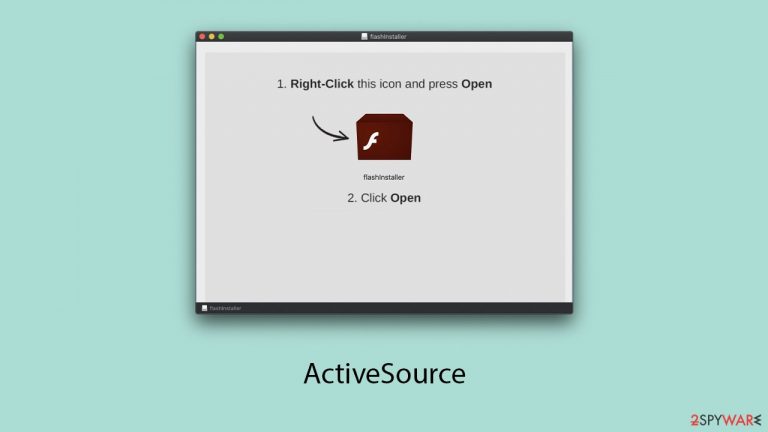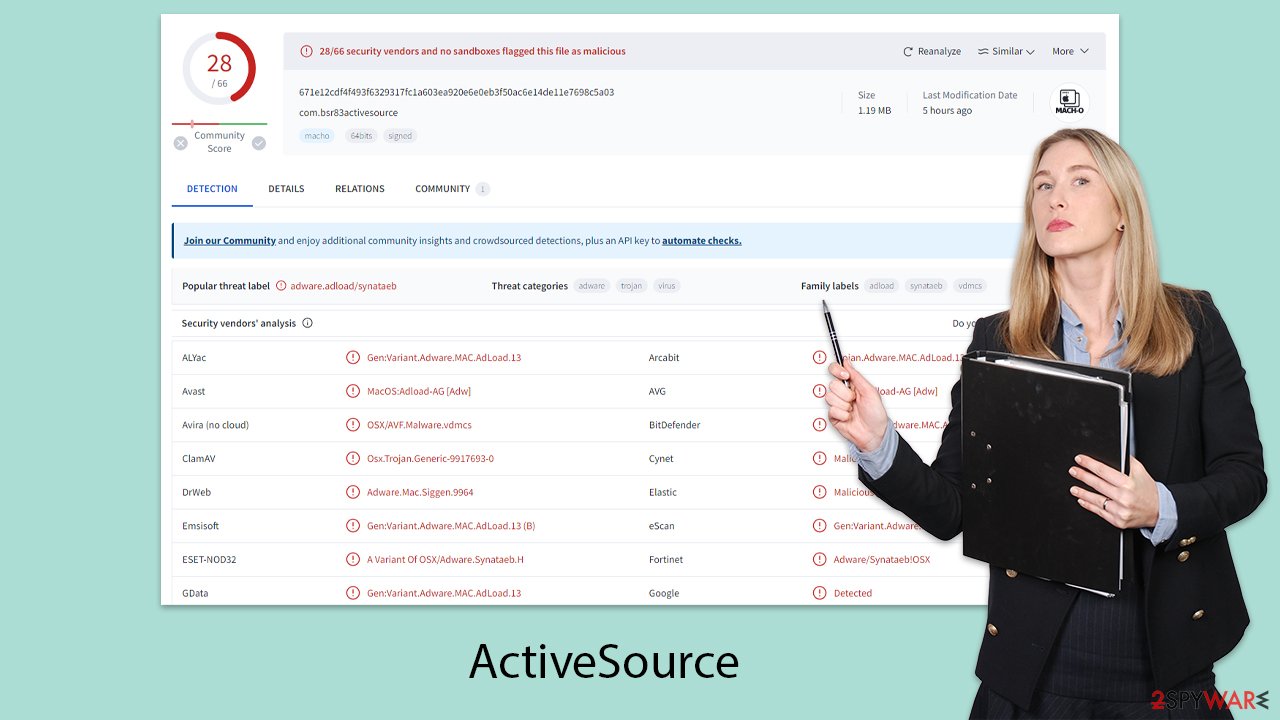ActiveSource Mac virus (Free Guide)
ActiveSource Mac virus Removal Guide
What is ActiveSource Mac virus?
ActiveSource is a malicious Mac application that can compromise your security

ActiveSource is a type of Mac malware that you might have accidentally installed, usually when you're deceived by a fake Flash Player update or when you download illegal software from risky websites. If your Mac is infected with this virus, you'll likely encounter more malicious ads, redirects, sponsored links, and other intrusive content while browsing.
Removing ActiveSource can be quite challenging because it installs various harmful files on your system. This malware, which is part of the Adload family, is recognized by its unique icon featuring a magnifying glass with a colored background (commonly blue, teal, green, or gray). The virus is known to hijack browsers, steal user data, and evade Mac's built-in defenses. If you think your Mac is infected, it's crucial to follow detailed instructions to remove the malware effectively.
| Name | ActiveSource |
| Type | Mac virus, adware, browser hijacker |
| Malware family | Adload |
| Distribution | Fake Flash Player installers or pirated software from high-risk sources |
| Symptoms | A suspicious browser extension installed on the web browser; search and browsing settings altered to another provider; new profiles and other elements created on the accounts; increased number of ads and redirects |
| Dangers | Personal data disclosure to cybercriminals, system compromise, installation of other malware, financial losses |
| Removal | You can employ powerful security software to check your system for infections, for example, SpyHunter 5Combo Cleaner. The manual PUA uninstall guide is also available below |
| System optimization | You should remove caches and other web data to prevent data tracking – use the FortectIntego repair and maintenance tool |
How does the ActiveSource virus spread?
Adload variants are highly effective, primarily due to their distribution methods. One of the main ways to get infected with the ActiveSource virus (or any other variant) is through fake Flash Player updates or pirated software installers.
When you see an online message claiming your system needs a Flash Player update, it's always fake, and you should avoid interacting with it. Flash has been discontinued and is no longer supported, as the technology behind it is outdated, with alternatives like HTML5 available for years.
Another common way to install malware is through illegal software. Cybercriminals often use torrents and similar methods to distribute dangerous malware, including ransomware. To protect your system, it's best to avoid such installers entirely.
What is the ActiveSource virus capable of?
ActiveSource, like other variants from the Adload family, poses a significant malware threat capable of causing extensive damage to Mac systems. Once it infiltrates, the malware quickly changes the user's browser settings, altering the homepage and default search engine. This is mainly done to generate revenue through ads and may redirect search queries through unexpected channels, leading to potentially harmful search results.
Beyond the annoying browser modifications, the malware can severely impact user privacy and security. By installing itself with escalated permissions, it uses AppleScript to bypass Mac defenses such as XProtect.

With these elevated permissions, the malware can monitor a user's online activities, collecting sensitive information like passwords, account details, and credit card numbers. This exposes users to serious privacy risks, making it essential to avoid entering any sensitive information while the system is compromised.
ActiveSource and other Adload malware often promote malicious websites, which may contain additional viruses or promote fake service subscriptions. Interacting with these links can increase the risk and potentially cause further damage to the user's system. Therefore, it is crucial to avoid clicking on any advertised links while an infection is present.
Removal instructions
Removing ActiveSource presents a unique challenge due to its operation with elevated system permissions. This malware not only deposits multiple files on the system but also creates new user profiles and login items. Using AppleScript, it effectively evades deletion by Mac's native security features, persisting even after the primary application or browser extension is removed.
Given these complexities, it is recommended to use specialized security software like SpyHunter 5Combo Cleaner or Malwarebytes for automated removal of the infection. Regardless of the removal method, clearing your web browser's cache is advisable to prevent future issues.
If you decide to tackle the removal manually, be aware that background processes related to the malware could obstruct your efforts. To address this, use the Activity Monitor to identify and terminate these processes before proceeding.
Remove the main app components
- Open Applications folder
- Select Utilities
- Double-click Activity Monitor
- Here, look for suspicious processes related to adware and use the Force Quit command to shut them down
- Go back to the Applications folder

- Find the virus name in the list and move it to Trash.
The PLIST files are small config files, also known as “Properly list.” They hold various user settings and hold information about certain applications.
- Select Go > Go to Folder.
- Enter /Library/Application Support and click Go or press Enter.
- In the Application Support folder, look for any dubious entries and then delete them.
- Now enter /Library/LaunchAgents and /Library/LaunchDaemons folders the same way and delete all the related .plist files.

Upon infiltration, the virus establishes new user profiles and login items, securing its persistent presence on your system. This is probably the reason you find it difficult to uninstall the application or browser extension.
- Go to Preferences and select Accounts
- Click Login items and delete everything suspicious
- Next, pick System Preferences > Users & Groups
- Find Profiles and remove unwanted profiles from the list.
Take care of your browsers
ActiveSource requires access to multiple areas of the operating system to function, but the browser is the most critical since ads are primarily delivered to users through it.
First, try uninstalling the primary browser extension using the same procedure as for conventional extensions. Depending on various circumstances, this step may or may not be effective (the app might simply be grayed out). To ensure all remnants are properly removed, delete web browser cookies, caches, and other site data.
If none of these methods work and you are still stuck with the browser extension, resetting your browser will remove everything on it. As a last resort, you might consider completely reinstalling the browser.
Safari
- Click Safari > Preferences…
- In the new window, pick Extensions.
- Select the unwanted extension and select Uninstall.

Google Chrome
- Open Google Chrome, click on the Menu (three vertical dots at the top-right corner) and select More tools > Extensions.
- In the newly opened window, you will see all the installed extensions. Uninstall all the suspicious plugins that might be related to the unwanted program by clicking Remove.

If you could not uninstall the extension regularly, you could reset your browser instead. Use the following:
Safari
- Click Safari > Preferences…
- Go to the Advanced tab.
- Tick the Show Develop menu in the menu bar.
- From the menu bar, click Develop, and then select Empty Caches.

Google Chrome
- Click on Menu and select Settings.
- In the Settings, scroll down and click Advanced.
- Scroll down and locate Reset and clean up section.
- Now click Restore settings to their original defaults.
- Confirm with Reset settings.

Finally, you should clear browser caches by removing cookies and other trackers. You can use an automatic solution like the FortectIntego maintenance utility for this task, although it can also be done manually:
Safari
- Click Safari > Clear History…
- From the drop-down menu under Clear, pick all history.
- Confirm with Clear History.

Google Chrome
- Click on Menu and pick Settings.
- Under Privacy and security, select Clear browsing data.
- Select Browsing history, Cookies and other site data, as well as Cached images and files.
- Click Clear data.

Getting rid of ActiveSource Mac virus. Follow these steps
Remove from Google Chrome
Delete malicious extensions from Google Chrome:
- Open Google Chrome, click on the Menu (three vertical dots at the top-right corner) and select More tools > Extensions.
- In the newly opened window, you will see all the installed extensions. Uninstall all the suspicious plugins that might be related to the unwanted program by clicking Remove.

Clear cache and web data from Chrome:
- Click on Menu and pick Settings.
- Under Privacy and security, select Clear browsing data.
- Select Browsing history, Cookies and other site data, as well as Cached images and files.
- Click Clear data.

Change your homepage:
- Click menu and choose Settings.
- Look for a suspicious site in the On startup section.
- Click on Open a specific or set of pages and click on three dots to find the Remove option.
Reset Google Chrome:
If the previous methods did not help you, reset Google Chrome to eliminate all the unwanted components:
- Click on Menu and select Settings.
- In the Settings, scroll down and click Advanced.
- Scroll down and locate Reset and clean up section.
- Now click Restore settings to their original defaults.
- Confirm with Reset settings.

Remove from Mozilla Firefox (FF)
Remove dangerous extensions:
- Open Mozilla Firefox browser and click on the Menu (three horizontal lines at the top-right of the window).
- Select Add-ons.
- In here, select unwanted plugin and click Remove.

Reset the homepage:
- Click three horizontal lines at the top right corner to open the menu.
- Choose Options.
- Under Home options, enter your preferred site that will open every time you newly open the Mozilla Firefox.
Clear cookies and site data:
- Click Menu and pick Settings.
- Go to Privacy & Security section.
- Scroll down to locate Cookies and Site Data.
- Click on Clear Data…
- Select Cookies and Site Data, as well as Cached Web Content and press Clear.

Reset Mozilla Firefox
If clearing the browser as explained above did not help, reset Mozilla Firefox:
- Open Mozilla Firefox browser and click the Menu.
- Go to Help and then choose Troubleshooting Information.

- Under Give Firefox a tune up section, click on Refresh Firefox…
- Once the pop-up shows up, confirm the action by pressing on Refresh Firefox.

How to prevent from getting adware
Access your website securely from any location
When you work on the domain, site, blog, or different project that requires constant management, content creation, or coding, you may need to connect to the server and content management service more often. The best solution for creating a tighter network could be a dedicated/fixed IP address.
If you make your IP address static and set to your device, you can connect to the CMS from any location and do not create any additional issues for the server or network manager that needs to monitor connections and activities. VPN software providers like Private Internet Access can help you with such settings and offer the option to control the online reputation and manage projects easily from any part of the world.
Recover files after data-affecting malware attacks
While much of the data can be accidentally deleted due to various reasons, malware is one of the main culprits that can cause loss of pictures, documents, videos, and other important files. More serious malware infections lead to significant data loss when your documents, system files, and images get encrypted. In particular, ransomware is is a type of malware that focuses on such functions, so your files become useless without an ability to access them.
Even though there is little to no possibility to recover after file-locking threats, some applications have features for data recovery in the system. In some cases, Data Recovery Pro can also help to recover at least some portion of your data after data-locking virus infection or general cyber infection.
